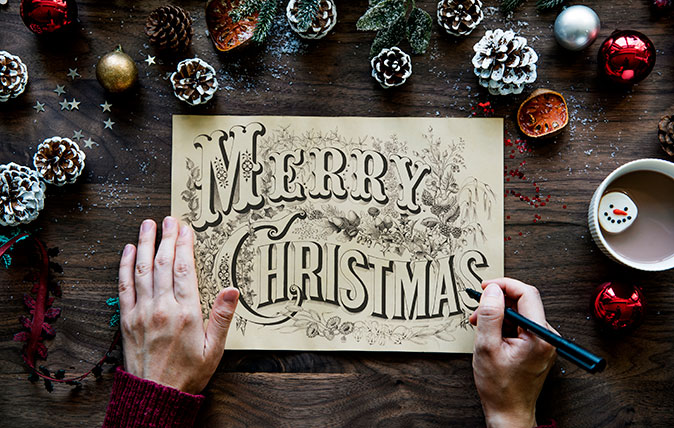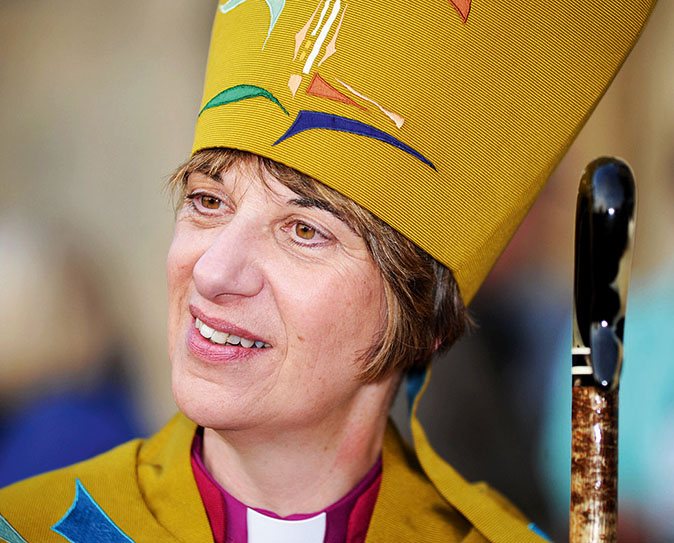The Country Life Christmas message, by the Bishop of Gloucester: ‘The light shines in the darkness and the darkness of the present can never put it out’
The Rt Revd Rachel Treweek, Bishop of Gloucester, delivers our Christmas message this year, on embracing the hopes and fears of all the years.

Country Life is packed with pictures to stimulate the senses: idyllic scenery, mouth- watering food, exquisite decorations and tantalising advertisements for a cornucopia of seasonal gifts and products. Of course, by their very nature, photo-graphs are snapshots of the past. In them, we encounter a moment from ‘before’.
This reflects something of the way we live in December. Memories and emotions from our past are aroused by the smells, tastes, sounds and images of Christmas present: cinnamon and pine, mince pies and mulled wine, carols and songs – and the inevitable scenes of snowmen, robins, reindeer and Father Christmas.
I confess to being one of those people who loves the anticipation of Advent and the run-up to Christmas proper. I count myself fortunate to have so many good childhood memories: Christmas Eve carol singing on the doorsteps of neighbours; waking early to a bulging stocking at the end of the bed, complete with the obligatory tangerine in the toe; and opening presents around the tree with family and friends.
However, sadness and yearning are by no means absent from those recollections of Christmases past. There are memories of loved ones no longer here, the wistfulness that comes from not being with those now some distance away and the fleeting ache for homes no longer lived in.
"At the heart of Christmas is the heart of God, who is love, come to Earth as one of us, sharing in joy, celebration, sadness and struggle"
For me, all those reawakened senses and memories coalesce around a tale of the past, which speaks of a love that has changed both present and future. It’s a tale of a vulnerable baby born in the Middle East about 2,000 years ago at a time of much uncertainty and fear. The parents had experienced a long and exhausting journey, forced upon them by the fickle decree of an occupying power. The child was born unpreparedly in an animal shelter with a trough for a cot.
The first guests were local caretakers (albeit of sheep) and, in time, came other visitors from distant places – curious and learned foreigners who connected the past with the future as they looked at the night stars. It was a story that was to challenge accepted norms and shatter our assumptions about power and significance.
Although none of this was ever captured in sepia print or digital image, that story of so many years past and miles distant will be seen once again in new representations on Christmas cards and Nativity re-enactments in schools and churches. Children’s heads will be wrapped with tea towels and tinsel as tiny shepherds and angels bring delight to adoring adults, all of us mindful that Herod might get stage-fright and the innkeeper burst into tears. That’s to say nothing of the lobsters we’ve been saddled with since Love Actually was released in 2003.
Exquisite houses, the beauty of Nature, and how to get the most from your life, straight to your inbox.

So much of this will be caught on our mobile phones and shared on social media. Snapshots of the present, but ones that speak of the past and are soon to become part of history. This is equally true in the retelling of the Christmas story in music, as carols are sung joyfully in settings from churches to pubs and from town squares to village greens.
However, as Christmas sparks connections with the past, my prayer will be that all our hearts are ignited by the realisation that the story of the first Christmas fills both our present and our future.
At the heart of Christmas is the heart of God, who is love, come to Earth as one of us, sharing in joy, celebration, sadness and struggle. Jesus Christ, the Son of God, the baby grown to be man, loved us to death. Literally. However, God is for the whole of our life, not Christmas alone and, if we fast forward to Easter (which the shops will surely do), we see the continuation of the story.
"I will give thanks for God’s love and the fundamental truth that the light shines in the darkness and the darkness of the present can never put it out"
We move from a baby in an animal trough to a man hanging on a cross, to a burial tomb now empty. The angels who sang glory to God on the night of that first Christmas are now singing of God’s love as stronger than death itself. The God of transformation will one day make all things new.
This is the reason for confidently pulling the crackers and gleefully tearing off the wrapping paper. Whatever the past held, the present is hope and God’s transform-ation is guaranteed. Nothing can stop God loving – not past, present or future – and the heart of God will continue holding the pain of the world’s brokenness until that special day when there will be no more dying and no more tears from anyone (including innkeepers).
As I celebrate Christmas in the beauty of ancient Gloucester Cathedral and our historic village churches, I’m already looking forward to O Little Town of Bethlehem and singing once again the words: ‘The hopes and fears of all the years are met in thee tonight.’
As I think of Bethlehem and the world’s continuing terrible brokenness, I’m renewed yet again with deep gratitude. Grateful that, because of God’s action in that Middle Eastern cowshed so many years ago, we can live in the present without fear as we look to the future with hope.
In the flicker of candles in dimly lit churches this Advent, I will call back to mind that first Christmas and my own Christmases since and I will give thanks for God’s love and the fundamental truth that the light shines in the darkness and the darkness of the present can never put it out. I suspect I’ll take out my phone to capture a Christmas moment or two, too.
By The Rt Revd Rachel Treweek, Bishop of Gloucester
Toby Keel is Country Life's Digital Director, and has been running the website and social media channels since 2016. A former sports journalist, he writes about property, cars, lifestyle, travel, nature.

